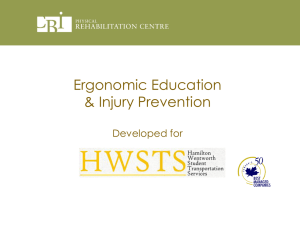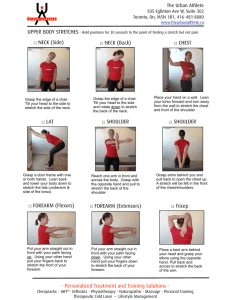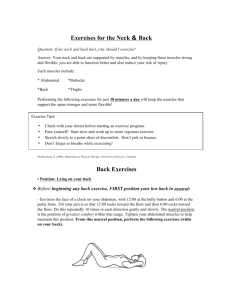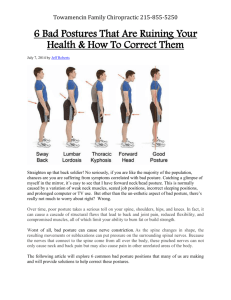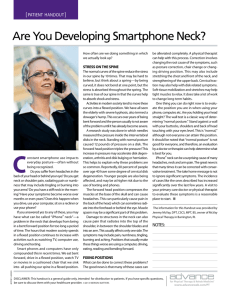Stay Healthy in Your Office Environment
advertisement
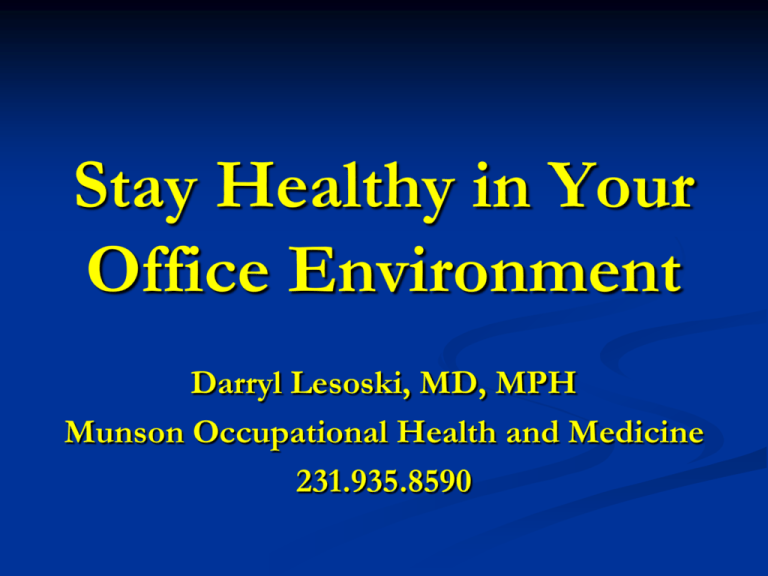
Stay Healthy in Your Office Environment Darryl Lesoski, MD, MPH Munson Occupational Health and Medicine 231.935.8590 Objectives State of the Nation Healthy Lifestyle / Behaviors in/out of Work Risks Associated with Poor Ergonomics Introduce Office Ergonomics Desk / Office Exercises / Activities Stimulate Your Interest for More Information Resources Office Ergonomics - A Guide to a Healthier, More Productive, and a Happier Work Environment The Problem 70% of the U.S. work force now sit on the job, many in front of computers. With so much work being done in a seated position today, a comfortable workstation is of great importance. Poor sitting posture and poorly designed workspaces are major causes of neck and back pain. Physiological Rationale The human body was not designed to sit for extended periods of time, or work in awkward positions that chronically contract or stretch muscles. Therefore, a well-designed workstation and proper sitting postures are essential in reducing and preventing potential problems caused by the demands of today's jobs. State of the Nation Modifiable health risks: smoking, obesity, poor nutrition, and physical inactivity Well-established links to preventable diseases Degrade quality of life and shorten life span. Diabetes, coronary heart disease, and hypertension Studies consistently link health risks (body mass and smoking) to productivity outcomes Illness absences, on-the-job injuries, and reduced job performance. STUDY: Modifiable Health Risks and Illness Absence From Work; JOEM, Volume 55, Number 3, March 2013 Results: Workers who lost weight or increased their frequency of light exercise also saw their illness absences decrease over a 2-year period. Some, but not all, of the relationship is mediated by the change in health status. Conclusion: The findings are consistent with the proposition that both employers and employees could benefit from efforts to support better health habits. State of the Nation 66% of the growth in national health care spending over the past 20 yrs can be attributed to Americans’ worsening lifestyle habits: in particular the epidemic rise in obesity rates. On-the-job impairment caused by poor health is estimated to account for 60% of total health-related costs for common health conditions such as diabetes, hypertension, and heart disease. Stewart and colleagues estimated that productivity losses related to personal and family health cost US employers $226 billon in 2006, equivalent to $1685 per employee per year. Activity Recommendations AHA Recommendation – this is the minimum At least 30 minutes of moderate-intensity aerobic activity at least 5 days/week for a total of 150 minutes OR At least 25 minutes of vigorous aerobic activity at least 3 days/week for a total of 75 minutes; or a combination of the two AND Moderate to high intensity musclestrengthening activity at least 2 or more days per week. Moderate-intensity aerobic activity means you're working hard enough to raise your heart rate and break a sweat. One way to tell is that you'll be able to talk, but not sing the words to your favorite song. Examples of activities that require moderate effort: Walking fast, Doing water aerobics, Riding a bike on level ground or with few hills, Playing doubles tennis, Pushing a lawn mower Build up over time If you want to do more vigorous-level activities, slowly replace those that take moderate effort like brisk walking, with more vigorous activities like jogging. Vigorous-intensity aerobic activity means you're breathing hard and fast, and your heart rate has gone up quite a bit. If you're working at this level, you won't be able to say more than a few words without pausing for a breath. Examples that require vigorous effort: Jogging or running, Swimming laps, Riding a bike fast or on hills, Playing singles tennis, Playing basketball Activity Ideas Get out the leash and walk your dog. Take your child for a brisk walk: one-on-one time; scavenger hunt. Mall walk. Window shop and people watch Join a team. Team sports, maintains motivation and accountability. Walk and talk. When talking, you don’t have to be glued to your seat. Tune into fitness during TV time. Walk, jog in place or use the treadmill at the gym while you watch your favorite 30-minute show. Park and walk. Spare yourself the stress and gain more energy by parking far. Take the stairs. You may huff and puff at first, but over time, your body will thank you. Dance! Do it in a ballroom, at a club or even in your living room. You’ll burn calories and gain a new hobby. Skip the cake, say goodbye to pie and take a walk after dinner. Activity Ideas at Work Brainstorm project ideas with a coworker while taking a walk. Create an exercise accountability partnership. Walk during business calls when you don't need to reference important documents. Stand while talking on the telephone. Walk down the hall to speak with someone rather than using the telephone. Take the stairs instead of the elevator. Or get off a few floors early and take the stairs the rest of the way. Download some audio fitness coaching. Participate in or start a recreation league at your company. Form a sports team to raise money for charity events. Join a fitness center or YMCA near your job. Work out before or after work to avoid rush-hour traffic, or drop by for a noon workout. Schedule exercise time on your business calendar and treat it as any other important appointment. Walk around your building for a break during the work day or during lunch. Some have mastered the art of typing while on a treadmill by securing the laptop to the base. Stretch Your Neck Stiffness Away Commonly-Experienced Aches During Work is neck strain or shoulder stiffness. When working in front of the computer, people tend to hunch forward. Ideally we should be keeping our posture upright. Easy to do that at the start of a work-day Our muscles need a break from sustaining an upright posture, so when muscles get fatigued, our posture collapses and we hunch. When we hunch, a lot of things happen. But for simplicity’s sake, we’ll just focus on these 2 things: 1. Tightening/Shortening of neck muscles. (UpperTrapezius, Levator Scapulae) 2. Tightening of chest muscles. (Pectoral major and minor) When we hunch forward, our neck tends to bend backwards and our shoulder-blade bone tends to elevate. This sort of posture tends to result in the shortening of the UpperTrapezius and Levator Scapulae muscles, and there’s where the shoulder stiffness experience comes in. When we work, our arms and hands are always in front of us. Combine that with hunching forward, our pectoral (chest) muscles will tend to become tight. When it’s tight, it will further move us into a hunched posture. Neck and Shoulder Basics 1. 2. 3. Placement of screen & documents determines neck and shoulder posture. Neck and shoulders will be up/ down/ twisted or reaching based on position of equipment. Most people have the monitor too high. Leads to dry eyes and neck strain. Where do you place magazines or papers to read? Probably about chest-height and angled with the top further away compared to the bottom. Use the normal reading position for the monitor. The top of your screen should be eye-level or lower. With the proper tilt/ angle (towards the eyes), the monitor can be quite low. 4. Bi-focal or tri-focal: monitor considerably lower to prevent head tipping up. 5. If the screen image is too small, or the monitor is too far away = forward position. 6. Glare spots reflected off the screen or direct light shining in your eyes can cause you to bend or lean in weird positions = neck tension. 7. Place your documents up on an angle to straighten the neck, place them near the monitor to limit twisting, at similar height. 8. Reaching to the mouse, keyboard, or other supplies can cause strain. Working with the arm extended and unsupported can increases shoulder strain. Place frequently-used items closer or find a place to support the arm. 9. Recommend placing the keyboard relatively low, near your resting elbow height. Otherwise shrug shoulders. 10. Elbows winged out to the side to reach for the arm rests? Strain to the shoulder muscles. Adjust armrests closer, or work without using the armrests. 11. Narrow shoulders? You may be rotating the arm/ shoulder to reach mouse -think windshield wiper motion. Can over-work the small rotator cuff muscle in the upper shoulder blade. Ideal Office Ergonomic Features Hand & Arm Injuries MSDs can happen when there is very little repetitious work. Possible causes of MSDs include: Repetition. Holding one position. Non-neutral postures. “Neutral” is considered to be the position about halfway through the available range of motion for the joint. Localized pressure. Direct pressure can cause damage in the long run. The wrist and elbow are locations of concern. Use of force. Even small exertions can cause stress if small muscles are involved. Cold temperatures. Vibration Rules of thumb for preventing MSDs are: • Break up repetitious work. Relax. Don’t use your muscles to hold your fingers, hands or shoulders in a particular position. Avoid positions near the extremes of your joints’ range of motion — the most neutral joint position is about halfway. Minimize contact with hard or sharp surfaces. Don’t use too much force- ‘hitting’ the keys or squeezing the mouse. Notice any exertions you have to make and see if they can be eliminated. They can be subtle exertions, such as pulling a hard-toreach drawer or lifting a heavy file. Move with an even motion. Avoid snapping the wrist or jerking against outside forces. Keep your hands and fingers warm. • • • • • • • Physical workstation design, physical tool design, and adjustability are important factors. Three less tangible but extremely important factors are: • Job design- Examples of poor job design are infrequent or inflexible breaks, low activity variety, and fast pace. • Stress control – Examples of stressors are deadlines, monitoring, and bad management. • Individual workstyle – Examples of harmful workstyles (in the context of computer work, for instance) are how hard the individuals hits keys, how the individual holds his/her wrists, excessive mousing (e.g. grasping the mouse while paused to read or mousing rather than using page Up/Down button) and where the individual places the mouse. Most MSDs are preventable and curable if caught early. Early signs may include persistent pain, tingling, numbness, burning, or aching. The signs may be constant or may occur mostly after certain activities. Some people get MSDs because their bodies are vulnerable to them. For example, CTS seems to be related to diabetes, overweight, thyroid conditions, hormone conditions, rheumatoid arthritis, previous injuries. Smoking may also increase the risk. Anyone with any of these conditions should be especially careful about prevention. MSDs can happen because of non-work activities. Hobbies, sports, driving, and even sleeping positions can contribute. One of the most important preventive measures is ‘variety.’ In other words, change posture and activities often. If possible, take breaks before getting tired. Extremely short breaks can be very helpful of frequent enough. A “break” doesn’t have to be a rest break — it can simply involve doing something else for awhile. SITTING Most of us sit too much. The average person sits more than 8 hours per day. Many office workers sit as much as 15 hours per day. Sitting puts your metabolism to sleep. 60 – 90 minutes of inactivity (like sitting) is enough to shut down the enzymes responsible for producing HDL- the “good” cholesterol, and for regulating blood sugar. Chronic inactivity is now thought to contribute to our diabetes epidemic. Sitting is harder on your back than standing. Use the following guidelines to maintain healthy work posture and get the most out of your ergonomic investment. 1. Seat Height: thighs are parallel to the floor; feet are flat on the floor or a footrest. 2. Depth of Seat Pan: at least 2” of clearance between the back of your knees and the front of the seat. 3. Height of your backrest so it fits comfortably on the small of your back. 4. Adjust your chair’s recline tension—if necessary—to support varying degrees of recline. Avoid using recline locks. 5. Lean back and relax in your chair to allow the backrest to provide full support for your upper body. 6 Keyboard Position your keyboard support 1 – 1.5” above your thighs. Angle the keyboard so it slopes slightly away. Keep your wrists in a straight, neutral posture while typing, and rest the heels of your palms—not your wrists—on a palm support. 7 Mouse Position your mouse close to the keyboard—preferably on a mousing platform—to minimize reaching. Avoid anchoring your wrist on the desk. Instead, glide the heel of your palm over the mousing surface and use your entire arm to mouse. 8 View - Position your monitor at least an arm’s length away with the top line of text at or just below eye level. Tilt the monitor away from you slightly, so your line of sight is perpendicular to the monitor. 9 Illuminate - Position your task light to the side opposite your writing hand. Shine it on paper documents but away from your monitor to reduce glare 10 Align - Align your monitor and the spacebar of your keyboard with the midline of your body. Arrange frequently used work materials within easy reach to minimize twisting and reaching. 11 Rest - Take two or three 30- to 60-second breaks each hour to allow your body to recover from periods of repetitive stress Workplace Tips Follow the 50-10 rule -every 50 minutes you work sitting at your desk, take a 10 minute break. During your break, walk around, stretch out your muscles (refer to stretches listed below), get a drink, etc. Useful Office Stretches These should be performed, while standing as straight as possible, at least twice throughout your workday. Hold each stretch for 30 seconds. Do not perform any stretch that cause pain, numbness, and/or tingling. Cervical Flexion - Bend your head forward so your chin touches your chest. Provide gentle overpressure to the back of your head with either hand. Hold for 30 seconds. You should feel a stretch along the back of your neck, and possibly down your spine. Cervical Extension - Tip your head back so you are looking at the ceiling. Hold for 30 seconds. You should feel a stretch along the front of your neck and underneath your chin. Cervical Side-bending - Tip your right ear toward your right shoulder. Provide gentle overpressure to the left side of your head with your right hand. Reach for the floor with your left hand. You should feel a stretch along the left side of your neck between your ear and shoulder. Hold for 30 seconds. Repeat to the other side. Cervical Rotation - Place your right hand on the back of your head. Turn your head to the left, so you are trying to look over your left shoulder. Provide gentle overpressure to the right side of your jaw with the back of your left hand (in a fist position). Hold for 30 seconds. Repeat to the other side. Lumbar Extension - Place your hands at the small of your back. Lean back and look up to relieve pressure on your lower back. Chin Tucks - Bend your head forward, chin towards your chest. Make a double chin with your head in the forward bent position. Hold for 5 seconds. You should feel a "stretch“ in the back of your neck. Repeat 10 times. Scapular Retraction - Keeping both your arms at your side, bend your elbows to 90 degrees. Squeeze your shoulder blades together. Hold for 10 seconds. Repeat 10 times Shoulder Shrugs - Keeping both arms at your sides, shrug your shoulders up towards your ears. Hold for 3 seconds. Roll and lower your shoulders backwards. Keep your elbows straight throughout the exercise. Repeat 10 times. Eye Exercises Eye Comfort Exercises -Blinking (produces tears to help moisten and lubricate the eyes) -Yawning (produces tears to help moisten and lubricate the eyes) -Expose eyes to natural light Palming -while seated, brace elbows on the desk and close to the desk edge, let weight fall forward cup hands over eyes, close eyes, inhale slowly through nose and hold for 4 seconds, continue deep breathing for 15-30 seconds Eye Movements -close eyes, slowly and gently move eyes up to the ceiling, then slowly down to the floor, repeat 3 times, close eyes, slowly and gently move eyes to the left, then slowly to the right, repeat 3 times Focus Change -hold one finger a few inches away form the eye, focus on the finger, slowly move the finger away, focus far into the distance and then back to the finger, slowly bring the finger back to within a few inches of the eye, focus on something more than 8 feet away, repeat 3 times Musculoskeletal Exercises Deep Breathing -while standing, or in an otherwise relaxed position, place one hand on the abdomen and one on the chest, inhale slowly through the nose, hold for 4 seconds, exhale slowly through the mouth, repeat Cable Stretch -while sitting with chin in, stomach in, shoulders relaxed, hands relaxed in lap, and feet flat on the floor, imagine a cable pulling the head upward, hold for 3 seconds and relax, repeat 3 times Side Bend: Neck Stretch -tilt head to one side (ear towards shoulder), hold for 15 seconds, Relax, repeat 3 times on each side Diagonal Neck Stretch -turn head slightly and then look down as if looking in your pocket, hold for 15 seconds, relax, repeat 3 times on each side Shoulder Shrug -slowly bring shoulders up to the ears and hold for approx. 3 seconds, rotate shoulders back and down, repeat 10 times Executive Stretch -while sitting, lock hands behind head, bring elbows back as far as possible, inhale deeply while leaning back and stretching, hold for 20 seconds, exhale and relax, repeat 1 time Foot Rotation -while sitting, slowly rotate each foot from the ankle, rotate 3 times in one direction, then 3 times in the opposite direction, relax, repeat 1 time Hand Shake -while sitting, drop arms to the side, shake hands downward gently, repeat frequently Hand Massage (Perform very gently!) -massage the inside and outside of the hand using the thumb and fingers, repeat frequently (including before beginning work) Finger Massage (Perform very gently!) -massage fingers of each hand individually, slowly, and gently, move toward nail gently, massage space between fingers, perform daily Wrist Stretch -hold arm straight out in front of you, pull the hand backwards with the other hand, then pull downward, hold for 20 seconds, relax, repeat 3 times each Simple solution to correct a hunched posture, is to stretch and relax these muscles: 1. Upper-Trapezius 2. Levator Scapulae 3. Pectoral Muscles Upper-Trapezius Stretch Levator-Scapulae Stretch Pectoral Stretch As a general thumb of rule, a stretch needs to be held for about 15secs for it to have an effect. By doing it 3 times of 15-secs each, it takes up only about 1 minute of your time! Resources Aim for a Healthy Weight: US Dept of Health and Human Services ACOEM Health and Productivity Toolkit Herman Miller: ergonomicshub.com humantech.com/resources/five-steps-to-improve-officeergonomics-e-book http://office-ergo.com http://office-ergo.com/wpcontent/uploads/2010/12/ErgoAdvocate_KeyBoard_Shor tcuts-v3.pdf Resources http://www.osha.gov/Publications/videoDispla y/videoDisplay.html http://hr.umich.edu/mhealthy/programs/ergon omics/help.html http://www.osha.gov/SLTC/etools/computer workstations/index.html http://hr.umich.edu/mhealthy/programs/ergon omics/help.html Resources http://www.steelcase.eu/en/resources/knowled ge-library/pages/ergonomics-at-desk.aspx http://www.ergonomicshub.com/ http://hr.umich.edu/mhealthy/programs/ergon omics/ergotutorial/toc.html http://www.ors.od.nih.gov/sr/dohs/HealthAn dSafety/Ergonomics/Pages/ergonomics_home. aspx Resources http://www.cdc.gov/niosh/topics/ergonomics/ http://www.osha.gov/SLTC/ergonomics/index.ht ml http://www.lni.wa.gov/Safety/Topics/Ergonomics /default.asp http://ergo.human.cornell.edu/ http://www.heart.org/HEARTORG/ http://www.cdc.gov/physicalactivity/everyone/guid elines/index.html Resources http://www.health.gov/paguidelines/adultguide /default.aspx http://www.health.gov/paguidelines/ http://www.fitness.gov/be-active/

